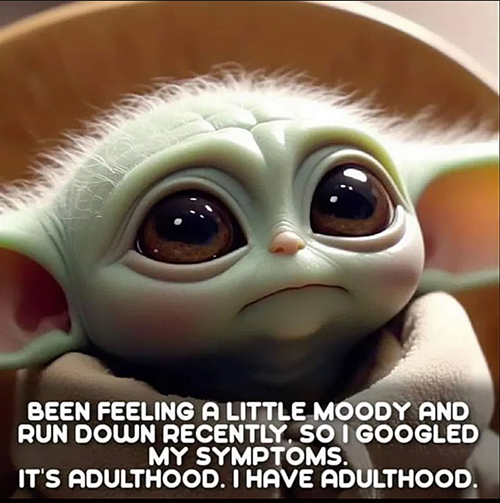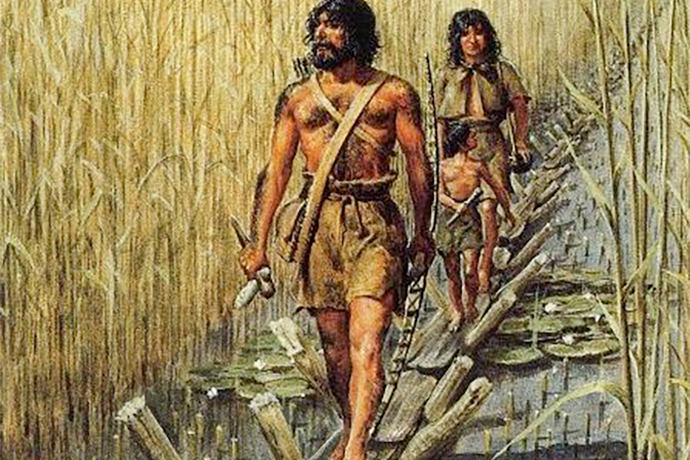Hello again! This week, I found a few links about a wooden bridge or track built almost 6000 years ago. It’s an engineering feat that shows how people used technology to solve a problem. Following on with the Scratch links last Wednesday, I also found a few beginner project tutorials. One tutorial lets you fly the Scratch cat. Not sure the cat approves. I also want to share some STEM apps that might make fun holiday gifts plus ancient Roman recipes. And I help answer the question, what is an atom? Enjoy following some or all of these links. And thank you for reading!
The Sweet Track
In 3806 BC, 5800 years ago, people living in Somerset marshland in Britain built bridges. They cut down trees then organized logs in a distinctive repeatable pattern. It enabled farmers to cross wet reed marshes from dry land to marsh islands. Like all landscapes, marshes evolve. Plants died and became peat bogs that preserved these bridges. Forty or so bridges have been dug out so far.
These bridges show the engineering challenge of cutting, shaping, and then organizing logs. They also reveal how people lived. Ceramics found near them had traces of cow milk, for example, the first evidence of dairy farming. People also dropped valuable items off the bridges. One find included a collection of stone axe blades brought from the French Alps to remote Britain. Another find is a child’s toy axe carved from wood. Kids today still play with wooden toys.
One of the most famous bridges is the Sweet Track. It’s named after the person who found it while digging ditches, Ray Sweet. To encourage people to find these bridges, they’re named after whoever finds them. People cut down the Sweet Track logs in spring 3806 BC, based on studying the rings and chemistry of the logs.
The Sweet Track runs for two kilometers, 1.2 miles, through reed marsh. Two logs driven into the marsh formed a x-shaped cradle with planks laid down on each cradle. You can walk across reconstructions of these bridges today, almost 6000 years later.
These bridges, also called tracks, are from the Paleolithic era. People had evolved from nomadic hunting to living in farms and villages. Their bridges show they also had started to solve engineering problems. And their solutions could be useful for more than their lifetime. Stonehenge probably is the most common example of Paleolithic engineering.
Sweet Track and other wooden trackways
https://avalonmarshes.org/heritage/sweet-track/
https://avalonmarshes.org/heritage/pre-history/
Sweet Track: 6,000-year-old Somerset walkway is preserved
https://www.bbc.com/news/uk-england-somerset-60203225
Neolithic Sweet Track recreated
https://youtu.be/z1dWX2BVJ6Q
The Sweet Track
https://youtu.be/aj8n_Bhte38
National Geographic: Bogs
https://education.nationalgeographic.org/resource/bog/
Neolithic
https://en.wikipedia.org/wiki/Neolithic
Life Expectancy From Prehistory to 1800 and Beyond
https://www.verywellhealth.com/longevity-throughout-history-2224054
Life Expectancy in History
https://en.wikipedia.org/wiki/Life_expectancy
Scratch Project: Make a Cat Fly
Last Wednesday, I wrote about getting started with Scratch with links to explore. For the next two or three weeks, I want to share simple projects you can try. Today the project shows how to make a cat fly. Not a real cat, of course. That would be dangerous and unkind. Then you can learn how to make your cat score points each time your cat catches a balloon.
I’ve also found a few other great beginner Scratch projects you can try. None of them are terribly difficult. And I found, for me, the Stu Lowe videos easy to follow. And because they’re videos, they’re easy to stop, back up, and replay. Total beginners like myself might want to start with the videos. Then make the cat fly with the tutorial at the first link.
Fun Scratch Tutorial for Kids: Scratch Lessons
https://www.create-learn.us/blog/scratch-tutorial-for-kids/
An introduction to Scratch Lesson 1 – Video lesson for younger students (Stu Lowe)
https://www.youtube.com/watch?v=8IrGQA0AdvA (Part 1)
https://www.youtube.com/watch?v=kd0fjHc0kGk (Part 2)
https://youtu.be/mgLbX6DlZ8U?si=F35bipmrNLzRkrMm (Part 3)
Scratch Beginner Tutorials
https://www.youtube.com/playlist?list=PLlryJer4FuggBT5-4ZDTcYivs7kJHowXb
Holiday Gifts: STEM Apps
Since the fall of 2014, I’ve published an annual holiday STEM/STEAM gift guide. This fall, I want to publish items in these Wednesday emails. It’s that time of year again.
The past five Wednesday emails I’ve shared holiday STEM gift ideas. So far, books and magazines, secret codes, robots, electronics, and board games. Today I want to talk about STEM apps.
If your kid has a phone or access to a home computer, apps and games might be a fun way for them to explore STEM. Apps can help kids learn about science, technology, engineering, art, and math. Using apps, kids get to solve problems, solve puzzles, and create new inventions. They learn critical thinking skills too.
Because these are apps, definitely pay attention to details. For example, when was the app last updated? Read the good and bad reviews. Price and fun factor mean little for software that’s not updated. And definitely decide if you’re for or against in app purchases. These are extra content, services, or subscriptions you can buy once in an app. Find out if key content and features require spending more money.
There’s also places online like NASA’s Kids Club and Space Place. PBS has something for kids too. They’re free and might be fun to share and enjoy together.
STEM Apps for Higher-Order Thinking
https://www.commonsense.org/education/lists/stem-apps-for-higher-order-thinking
NASA Science Space Place for Kids
https://spaceplace.nasa.gov/menu/play/
https://www.nasa.gov/learning-resources/nasa-kids-club/
NASA Apps
https://play.google.com/store/search?q=NASA kids&c=apps
https://apps.apple.com/us/developer/nasa/id355542146?see-all=i-phonei-pad-apps
Apple iTunes: STEM Apps for Kids
https://apps.apple.com/us/story/id1454330950
Google Play: Apps that Build STEM Skills
https://play.google.com/store/apps/editorial?id=mc\_dumblestore\_build\_stem\_skills\_fcp&hl=en
PBS Kids Videos and Apps
https://play.google.com/store/apps/dev?id=8332149447945516079
7 STEM Apps for Students: American Society of Mechanical Engineers
https://www.asme.org/topics-resources/content/7-stem-apps-for-students
Dormice for Dinner, Anyone?
Half the fun of history is reading about what people ate without having to eat it yourself. People ate some strange things. Then again, ten generations from now, people might wonder how we ate Big Macs.
A couple months ago my daughter did some research for me about ancient Roman recipes. She loves to cook. Mostly though, she wanted to earn money from me to buy a video game.
Talking with my daughter, I mentioned hearing Romans supposedly ate dormice. They’re small cute furry little mice. How could you eat something so small? With so little meat on them? Not mention the cuteness. How could you hurt something so cute?
My daughter found that wealthy ancient Romans did eat dormice. They kept them in pottery jars called dolia. The large jars only had holes for air flow and a lid. The dormice mostly slept in the darkness of the jars. People fed them acorns, chestnuts, and other fruits and nuts to fatten them up. Then they cooked the cute little guys. Stuffed them with minced pork and other meats. Along with pepper and pine nuts. Then glazed them with honey while cooking them.
Meanwhile, the not wealthy Romans ate food we recognize. All Romans ate three meals a day, like we do. They called breakfast the ientaculum and lunch the prandium. Dinner was the cena or vesperna. Breakfast usually was bread, cheese, and fruit. Lunch also had bread with veggies, cold meat, and eggs. It was often eaten at home after a morning at work or school. And dinner was porridge with veggies, fish, or other more interesting food. Most interesting to me is that Romans arranged their days to get business done by lunch. Then they spent mid to late afternoons at the baths socializing until dinner. Sounds like a nice life. 🙂
In looking online myself, I also found weirder recipes than dormice. Wealthy Romans also fancied flamingo tongues as a delicacy. I found a website about food and culture called Pass the Flamingo. That made me laugh. But it has some ancient recipes from different parts of the world. It’s worth a look if you’re interested.
Ancient Roman Recipes
https://www.pbs.org/wgbh/nova/article/roman-recipes/
Cook a classical feast: nine recipes from ancient Greece and Rome
https://www.britishmuseum.org/blog/cook-classical-feast-nine-recipes-ancient-greece-and-rome
Roman Meals
https://cibiantiquorum.com/roman-meals/
Around the Roman Table: Food and Feasting in Ancient Rome
https://press.uchicago.edu/Misc/Chicago/233472.html
https://www.alibris.com/search/books/isbn/9780226233475
Antique Roman Dishes – Collection
https://www.cs.cmu.edu/~mjw/recipes/ethnic/historical/ant-rom-coll.html
Dispelling Some Myths: Edible Dormouse anyone?
https://www.tastesofhistory.co.uk/post/dispelling-some-myths-edible-dormouse-anyone
Ten Bizarre, Weird Foods of Ancient Rome
https://crystallyn.substack.com/p/ten-bizarre-weird-foods-of-ancient
Dormice Delicacies: A Unique Appetizer of Ancient Rome
https://medium.com/@LegionLore/dormice-delicacies-a-unique-appetizer-of-ancient-rome-69880a183999
Glisglis – a Roman gift and a recipe for a festive dormouse
https://thehistoryjar.com/2020/12/01/glisglis-a-roman-gift-and-a-recipe-for-a-festive-dormouse/
Ancient Roman Recipes
https://www.youtube.com/playlist?list=PL1oLijmQLeB5jcMBfVpQSsUIc8UMeBGzR
Ancient Recipe: Braised Flamingo (Roman, 5th century CE)
https://passtheflamingo.com/2017/03/15/ancient-recipe-braised-flamingo-roman-5th-century-ce/
Pass the Flamingo
https://passtheflamingo.com/
https://www.instagram.com/passtheflamingo/
The Medieval Kitchen: Recipes from France and Italy
https://www.alibris.com/The-Medieval-Kitchen-Recipes-from-France-and-Italy-Odile-Redon/book/4274026
What is an Atom?
It was fun to research this answer. Because it is both simple and complicated. Simple because it’s all about matter. Rubber ducks, dogs, planets, almost anything is matter. Complex because atoms make up matter. Millions, billions, trillions, gazillions of atoms make up what we see in our world.
Neutrons, Protons, and electrons make up atoms. Protons have a positive charge and electrons have a negative charge. They attract each other. Neutrons have no charge and don’t affect how electrons behave. For every Proton, there’s one electron.
When you combine atoms, they make up molecules. Water is a molecule. Specifically, it’s H20: two atoms of Hydrogen and one atom of Oxygen. Hydrogen also is an element. So is Oxygen.
You may have heard of the Periodic Table? It’s a list of elements like Hydrogen and Oxygen. Each element has a unique number which is the number of protons in the element.
And I recently learned that how we describe electrons orbiting the nucleus of an atom is incorrect. Or not entirely accurate. They do exist around the nucleus of proton(s) and neutron(s). But it’s better to think of electrons being in nested shells around the nucleus of an atom.
What makes all this simple complexity interesting and useful? It’s the healthy and unhealthy interactions between elements and their atoms. It’s smashing atoms at high speed to see if you can create new elements. It’s also smashing atoms to see if you can prove or disprove the laws of physics. Knowing how atoms work also lets you find ways to extract Hydrogen atoms from water. That creates a useful energy source that’s greener than fossil fuels.
BBC Bitesize: Atoms and molecules
https://www.bbc.co.uk/bitesize/articles/zc86m39#z4dtxbk
What is an Atom? | The Smallest Thing | Learning Made Fun
https://youtu.be/DZDjiwJnqX0
Atomic Structure
https://www.arpansa.gov.au/understanding-radiation/what-is-radiation/ionising-radiation/atomic-structure
How Small is an Atom?
https://youtu.be/ukGLH_NrFH8
Inside Atoms: Electron Shells and Valence Electron
https://youtu.be/vxuBcOoGoD4
What is an Electron?
https://youtu.be/dgqHFpP1w2k
Atom
https://en.wikipedia.org/wiki/Atom
This Week
Our Sunday email this week has fun often offbeat links about a plane design that mimics shark skin, rogue waves, ancient Chinese inventions, how depression changes brain networks, and the sounds Pando makes. (Pando is the largest living organism on Earth.) Plus a few more fun STEM/STEAM links. Look for the email this Sunday!


